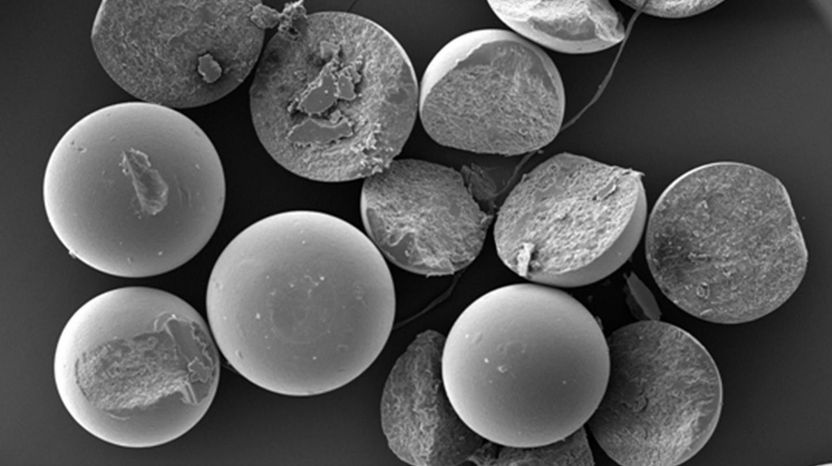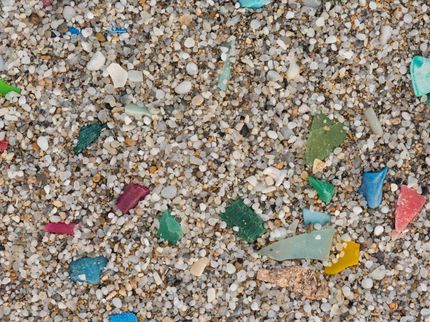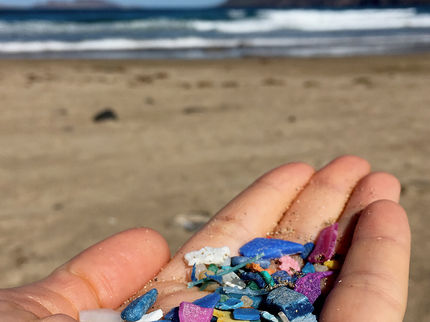Research demonstrates millions of plastic particles exist in cosmetic products
Everyday cosmetic and cleaning products contain huge quantities of plastic particles, which are released to the environment and could be harmful to marine life, according to a new study.

This image captured by an electron microscope shows polyethylene microbeads widely used in shower gel.
Thompson/Bakir/Plymouth University
Research at Plymouth University has shown almost 100,000 tiny 'microbeads' - each a fraction of a millimetre in diameter - could be released in every single application of certain products, such as facial scrubs.
The particles are incorporated as bulking agents and abrasives, and because of their small size it is expected many will not be intercepted by conventional sewage treatment, and are so released into rivers and oceans.
Researchers, writing in Marine Pollution Bulletin, estimate this could result in up to 80 tons of unnecessary microplastic waste entering the sea every year from use of these cosmetics in the UK alone.
The latest study was led by PhD student Imogen Napper, together with Professor of Marine Biology Richard Thompson, Professor of Organic Geochemistry Steve Rowland and Postdoctoral Researcher of Analytical Chemistry, Dr Adil Bakir.
Imogen said: "As the study unfolded I was really shocked to see the quantity of microplastics apparent in these everyday cosmetics. Currently, there are reported to be 80 facial scrubs in the UK market which contain plastic material, however some companies have indicated they will voluntarily phase them out from their products. In the meantime, there is very little the consumer can do to prevent this source of pollution."
Microplastics have been used to replace natural exfoliating materials in cosmetics and have been reported in a variety of products such as hand cleansers, soaps, toothpaste, shaving foam, bubble bath, sunscreen and shampoo.
There is growing evidence that the amount of plastics in marine waters is increasing, with around 700 species of marine organism being reported to encounter marine debris in the natural environment, and plastic debris accounts for over 90 per cent of these encounters.
Subsequent analysis using electron microscopy showed that each 150ml of the products could contain between 137,000 and 2.8million microparticles.
Professor Richard Thompson, who has been studying the effects of litter in the marine environment for over 20 years, said: "Using these products leads to unnecessary contamination of the oceans with millions of microplastic particles. There is considerable concern about the accumulation of microplastics in the environment; our previous work has shown microplastics can be ingested by fish and shellfish and there is evidence from laboratory studies of adverse effects on marine organisms."
Topics
Organizations
Other news from the department science
These products might interest you

Eclipse by Wyatt Technology
FFF-MALS system for separation and characterization of macromolecules and nanoparticles
The latest and most innovative FFF system designed for highest usability, robustness and data quality

DynaPro Plate Reader III by Wyatt Technology
Screening of biopharmaceuticals and proteins with high-throughput dynamic light scattering (DLS)
Efficiently characterize your sample quality and stability from lead discovery to quality control

Get the life science industry in your inbox
By submitting this form you agree that LUMITOS AG will send you the newsletter(s) selected above by email. Your data will not be passed on to third parties. Your data will be stored and processed in accordance with our data protection regulations. LUMITOS may contact you by email for the purpose of advertising or market and opinion surveys. You can revoke your consent at any time without giving reasons to LUMITOS AG, Ernst-Augustin-Str. 2, 12489 Berlin, Germany or by e-mail at revoke@lumitos.com with effect for the future. In addition, each email contains a link to unsubscribe from the corresponding newsletter.
Most read news
More news from our other portals
Last viewed contents
Of bio-hairpins and polymer-spaghetti - A spotlight on how entangled polymers flow and soften
Pharmaceutical Production with Reduced Waste - Platform technology for producing cephalosporin antibiotics




















































